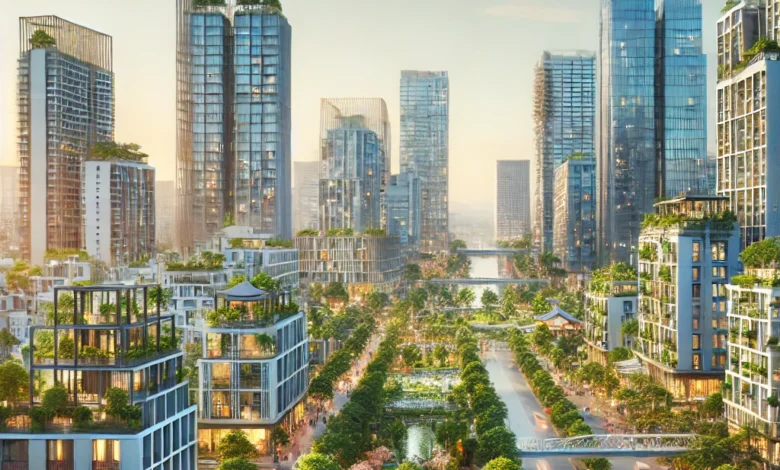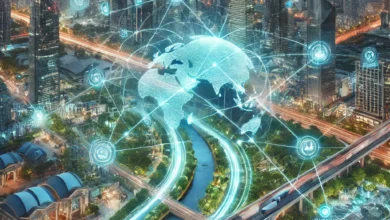A Beacon of Prosperity: The Rising Future of Vietnam’s Capital

Introduction:
Vietnam, with its rich history and vibrant culture, has always been a land of resilience and renewal. Over the past few decades, the country has been on a remarkable journey of transformation, particularly in its capital. The evolution of this city is a testament to the indomitable spirit of its people and the visionary strategies that have been implemented to steer it toward a prosperous future. As the heart of the nation, this capital city stands as a beacon of economic growth, cultural renaissance, and urban development, poised to become a major hub in Southeast Asia.
Urban Transformation: A Modern Metropolis Emerges
The capital city has undergone a significant metamorphosis, evolving from a historical town with colonial architecture into a modern metropolis brimming with skyscrapers, high-tech industries, and world-class infrastructure. The skyline of the city is now a mix of contemporary high-rises and traditional structures, reflecting the seamless blend of old and new. This urban transformation has not only elevated the city’s profile but also made it an attractive destination for investors, entrepreneurs, and tourists alike.
The city’s infrastructure has seen substantial upgrades, with new roads, bridges, and public transport systems that connect different parts of the city more efficiently. The expansion of the metro system, in particular, has been a game-changer, reducing traffic congestion and making commuting more convenient for residents and visitors. These developments are part of a larger vision to create a sustainable urban environment that supports economic growth while preserving the city’s cultural heritage.
Visit https://ketoangiakhang.vn/
Economic Growth: A Hub for Innovation and Business
The capital’s economy has been on a robust growth trajectory, driven by a surge in foreign investments, a burgeoning middle class, and a dynamic entrepreneurial ecosystem. The city has become a magnet for multinational corporations and startups, thanks to its favorable business environment, skilled workforce, and strategic location in Southeast Asia.
One of the key drivers of this economic boom is the focus on innovation and technology. The city has positioned itself as a tech hub, with numerous incubators, accelerators, and tech parks that nurture startups and foster innovation. The government’s proactive policies and incentives for businesses have further fueled this growth, making the capital a preferred destination for tech companies looking to expand their footprint in Asia.
Moreover, the city’s diverse economy, which spans sectors such as manufacturing, services, tourism, and retail, ensures its resilience against global economic fluctuations. This diversity, coupled with a young and educated population, provides a strong foundation for sustained economic growth in the years to come.
Cultural Renaissance: Preserving Heritage While Embracing Change
Despite its rapid modernization, the capital city has managed to preserve its rich cultural heritage, which is deeply embedded in its identity. The city’s numerous museums, temples, and historical sites offer a glimpse into its storied past, attracting millions of tourists every year. These cultural landmarks are not just relics of the past; they are living symbols of the city’s resilience and adaptability.
In recent years, there has been a renewed focus on promoting the city’s cultural heritage, with initiatives aimed at restoring historical buildings, supporting traditional arts and crafts, and organizing cultural festivals that celebrate the city’s unique identity. These efforts have not only boosted tourism but also instilled a sense of pride among the residents, reinforcing the city’s position as a cultural capital.
The city’s cultural renaissance is also reflected in its vibrant arts scene, which includes contemporary art galleries, music performances, and theater productions. This blend of traditional and modern cultural expressions enriches the city’s social fabric and contributes to its dynamic urban life.
Sustainable Development: Building a Greener Future
As the capital city continues to grow, sustainable development has become a top priority. The city’s leaders have recognized the importance of balancing economic growth with environmental preservation, and have implemented a range of initiatives to promote sustainability.
One of the key areas of focus has been reducing air pollution and improving air quality. The city has invested in cleaner public transportation, expanded green spaces, and promoted the use of renewable energy sources. These efforts have not only enhanced the quality of life for residents but also made the city a model for sustainable urban development in the region.
The city’s commitment to sustainability is also evident in its approach to urban planning. New developments are being designed with sustainability in mind, incorporating green building practices, energy-efficient technologies, and smart city solutions. These initiatives are helping to reduce the city’s carbon footprint and ensure that future generations can enjoy a clean and healthy environment.
Education and Talent Development: Preparing for the Future
The capital city’s success is closely tied to its focus on education and talent development. The city is home to some of the country’s top universities and research institutions, which are producing a steady stream of skilled professionals who are driving innovation and economic growth.
The city’s education system is also evolving to meet the demands of a rapidly changing economy. There is a growing emphasis on STEM (science, technology, engineering, and mathematics) education, as well as on developing soft skills such as creativity, critical thinking, and problem-solving. These skills are essential for the workforce of the future, and the city’s education system is equipping students with the tools they need to succeed in a globalized economy.
In addition to formal education, the city is fostering a culture of lifelong learning, with numerous opportunities for professional development and skills training. This focus on talent development is not only enhancing the city’s competitiveness but also ensuring that its residents can adapt to the challenges and opportunities of the 21st century.
Community and Social Well-being: Building a Cohesive Society
The capital city’s development is not just about economic growth and urbanization; it’s also about building a cohesive and inclusive society where all residents can thrive. The city’s leaders have implemented a range of social programs aimed at improving the quality of life for all citizens, particularly the most vulnerable.
These programs include affordable housing initiatives, healthcare improvements, and social services that support the elderly, disabled, and low-income families. By addressing social inequalities and ensuring that all residents have access to basic services, the city is creating a more equitable and just society.
Community engagement is also a key component of the city’s development strategy. The city’s leaders recognize the importance of involving residents in decision-making processes and have created platforms for citizens to voice their opinions and contribute to the city’s development. This inclusive approach is helping to build a sense of ownership and pride among the residents, fostering a strong and resilient community.
The Road Ahead: A Bright Future for Vietnam’s Capital
As the capital city continues to evolve, it is clear that its future is bright. The city’s transformation into a modern, dynamic, and sustainable metropolis is a testament to the vision and determination of its leaders and residents. With its strong economy, rich cultural heritage, and commitment to sustainability, the city is well-positioned to become a leading global city in the 21st century.
The road ahead will undoubtedly present challenges, but the city’s resilience and adaptability will ensure that it continues to thrive. As the city looks to the future, it will be guided by the same principles that have driven its success so far: innovation, sustainability, inclusivity, and a deep respect for its cultural heritage.
In conclusion, the capital city of Vietnam is a shining example of what can be achieved through visionary leadership, strategic planning, and the collective efforts of a determined populace. Its journey from a historical town to a modern metropolis is a source of inspiration, not just for other cities in Vietnam, but for urban centers around the world. The city’s future is full of promise, and as it continues to grow and evolve, it will remain a symbol of hope, progress, and prosperity.


